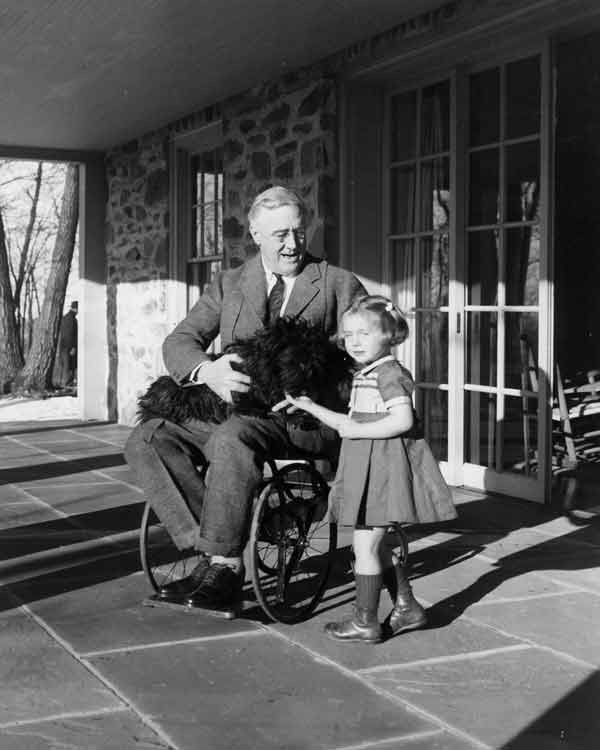President Franklin D. Roosevelt at Top Cottage with Ruthie Bie and Fala, February 1941. FDR Library Photo.
Through his rejection of prevailing social norms that confined wheelchair users and defined them as simply disabled, FDR and his wheelchairs reflect an important change in the social construction of disability.
Each year, March 1st is observed as International Wheelchair Day “to enable wheelchair users to celebrate the positive impact a wheelchair has in their lives.” According to the latest US Census data, almost 20 percent of the US population, or 61 million adults, live with a disability. About 10 percent have a visible physical disability or mobility impairment, and well over 3 million Americans use a wheelchair full-time. As one of our nation’s most famous wheelchair users, it seems fitting that we take a closer look at some of FDR’s wheelchairs to observe this important day.
In the final months of her own life, Eleanor Roosevelt reflected on FDR’s wheelchairs in an article she wrote for McCalls, telling us “I think the most original innovation was Franklin’s own invention: He converted several kitchen chairs into wheelchairs. Being armless and light of weight, they were extremely easy for my husband to manipulate.”1 There may be more than one reason FDR wished to design his own wheelchair, but let’s consider Eleanor’s statement at face value. In the earliest days of his life following paralysis, FDR might have used a wheelchair that belonged to his father. This chair, commonly referred to as an invalid chair, shares many characteristics with commercially produced wheelchairs during the late 19th and early 20th centuries. High backs, wide seats (this one measuring 52.3 inches), armrests, adaptable footrests, and a large wheelbase are characteristics that provided a level of comfort for the user as well as support for individuals without muscular control. Handlebars on the back of these chairs are included to accommodate an able-bodied person required to wheel the chair into motion. Though designed for mobility, their size was incompatible with flights of stairs, narrow doorways, and tight corridors in a house like Roosevelt’s. By contrast, the Colson wheelchair illustrated below, attempts to provide the user a level of autonomy with a narrower seat and the addition of hand rims on the large wheels relocated to the front. FDR may have used this Colson wheelchair and others like it during the earliest years of his paralysis. While the seat of the Colson chair measures substantially narrower at 40.5 inches, the wheel base with hand rims actually make this chair 4.5 inches wider than the Wakefield chair. Restriction and confinement are inherent in the overall design and likely required assistance to maneuver a body in and out of such chairs. Despite the changes, these chairs remain symbols of dependence.
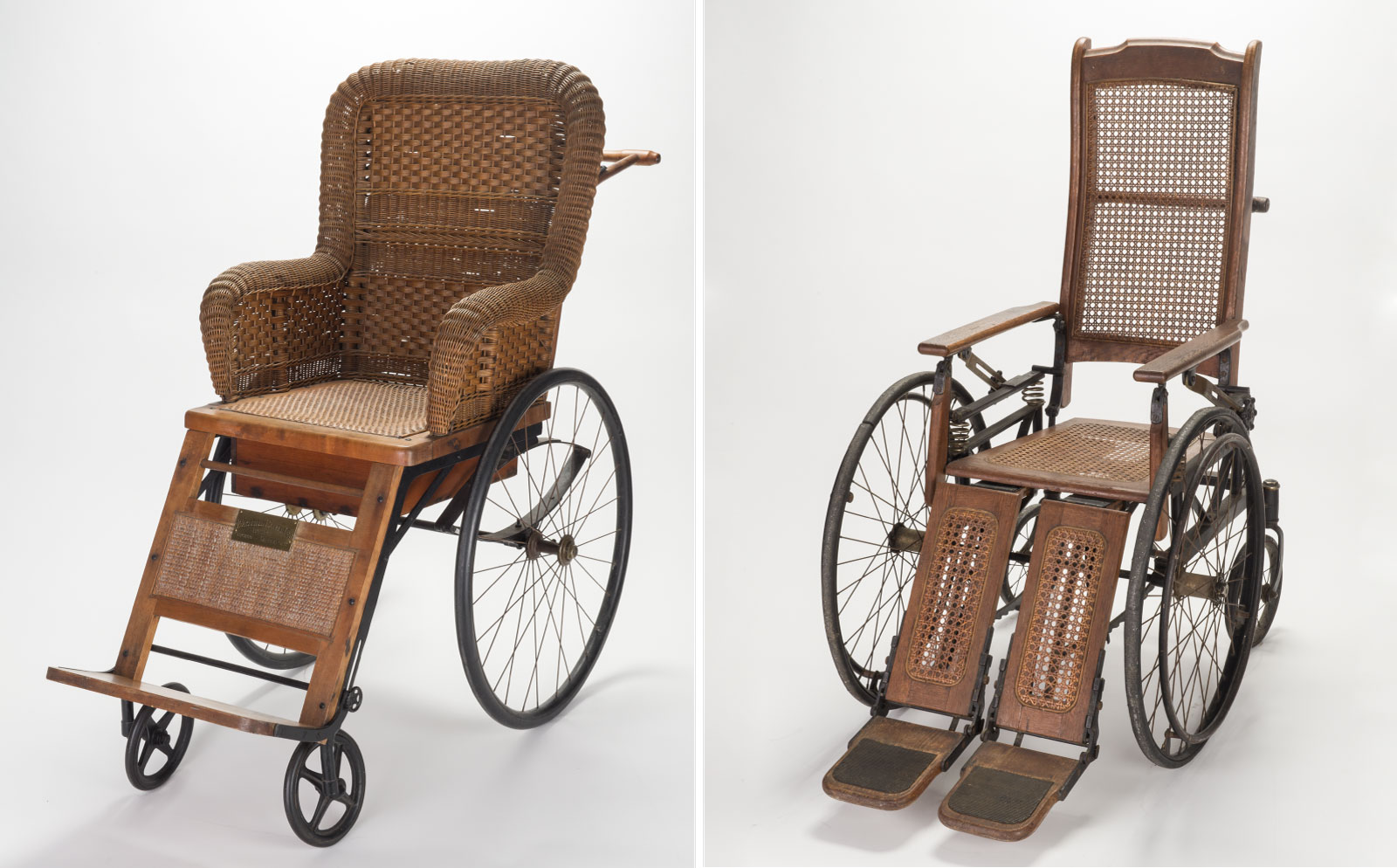
Invalid chair (HOFR 3041), Wakefield Rattan Company, possibly used by FDR’s father, James Roosevelt (left), and a Colson manufacture wheelchair, model C-37-B (HOFR 3069), possibly used by FDR during his early stage of poliomyelitis (right). According to a company advertisement, Colson wheelchairs were in use at leading institutions, including the Georgia Warm Springs Foundation. Both chairs in the collection of the Home of Franklin D. Roosevelt National Historic Site.

Wheelchair in the Executive Mansion, Albany, New York thought to have been used by FDR sometime during his terms as Governor from 1929-1932. Image courtesy of New York State Capitol. This wheelchair appears in a photograph of the Executive Mansion pool house taken during FDR’s tenure as Governor.

Wheelchair designed by FDR (HOFR 1554), Home of Franklin D. Roosevelt National Historic Site, NPS Photo.
A group of wheelchairs designed by FDR offer a stunning contrast to the manufactured wheelchairs. At a glance, these comparatively smaller wheelchairs appear to incorporate what Eleanor identified as modified kitchen chairs. On close inspection, one chair used by FDR at Hyde Park (HOFR 1554, illustrated above) retains remnants of the original legs sawn off to accommodate the wheelbase. The oak seat resembles Arts & Crafts style task chairs popular in the 1920s and easily obtained from many retail establishments. According to tradition, FDR’s wheelchairs were fabricated from these common chairs by a local blacksmith at Hyde Park.2 This chair appears in one of the rare photographs of FDR seated in a wheelchair. The chair slat-back matches that on the wheelchair photographed from behind FDR on the front terrace at Springwood in 1937. A similar wheelchair appears in a photograph of Top Cottage taken in May 1945, just within a month after FDR’s death. The reduction in size of these wheelchairs provided FDR the ability to more easily navigate Springwood’s narrow passages (with the addition of ramps) or the narrow aisles of his frequently used train car.
The chair that appears in the Top Cottage photo closely resembles a small wheelchair in the collection of the Little White House at Warm Springs, GA. Like the Hyde Park wheelchair, the Warm Springs wheelchair is fabricated from a modified common oak task chair (also with remnant legs) attached to a wheelbase. This is probably the wheelchair purchased for FDR on April 15, 1933 for twenty dollars and was possibly made at the foundation brace shop.3 When FDR established the Georgia Warm Springs Foundation in 1927, three years after his first visit to Warm Springs, he hired blacksmiths to fabricate leg braces, crutches, and wheelchairs.4 A important distinction among these two wheelchairs is that, unlike the wheelchair at Hyde Park, the Warm Springs chair includes hand rims.
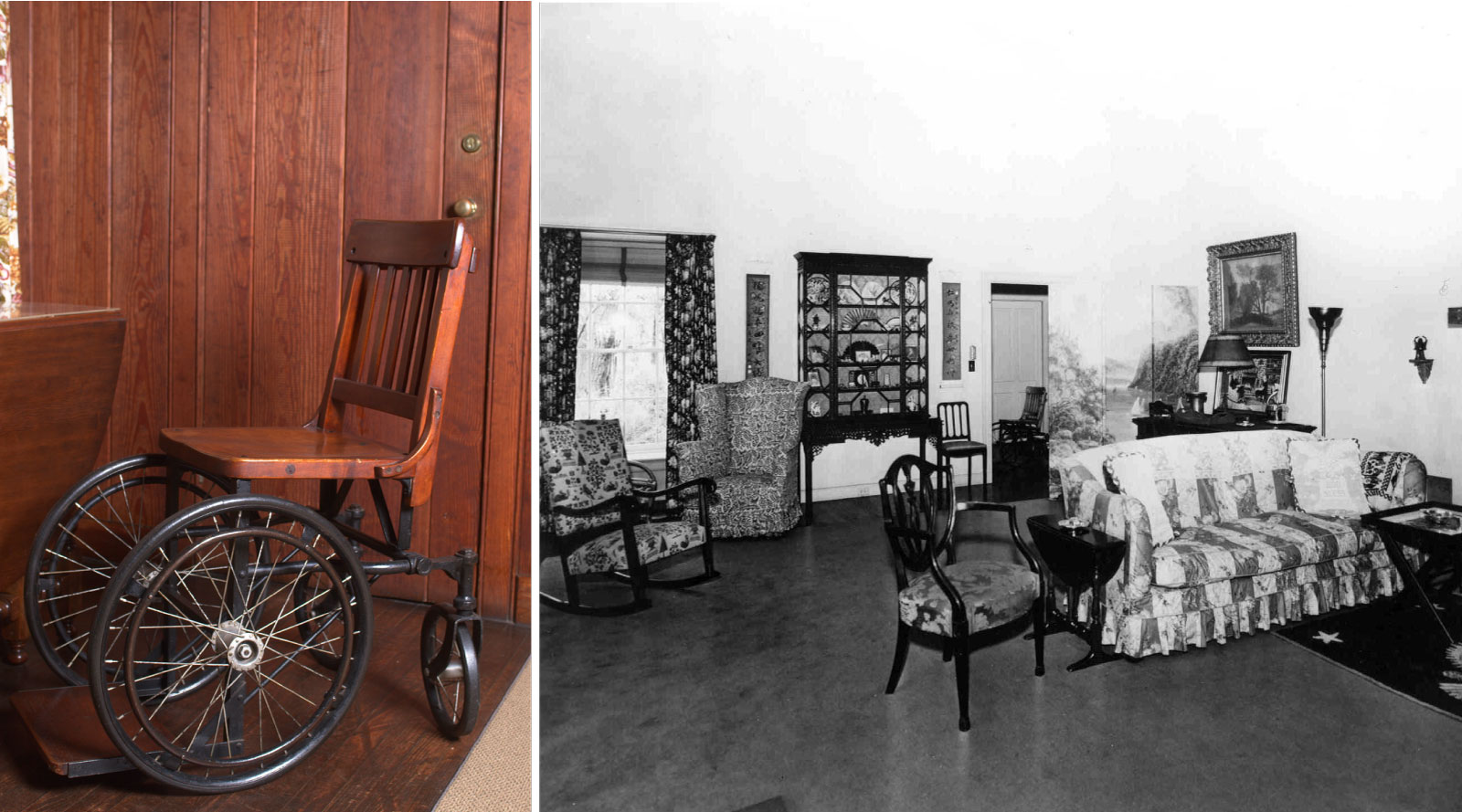
Left: Wheelchair designed by FDR, ca. 1933 (Roosevelt Little White House State Historic Site, Warm Springs, GA). Right: Detail of interior at Top Cottage, May 1945. The wheelchair seen in the entrance hall resembles the wheelchair now at Warm Springs. FDR Library Photo.
Designed to provide more functionality at home, these chairs hardly appear to be comfortable. The President’s grandson, Curtis Roosevelt, recalled
my grandfather used his wheelchair as little as possible. It was painful for him to ride on bare wood, and the muscles in his buttocks and thighs were not strong enough to hold him on the wheelchair unless he firmly grasped the side of it with one hand.”5
Upon entering a room, FDR quickly transferred into a desk chair or comfortable sofa. When a newspaper editor insisted that polio left him wheelchair-bound, FDR replied “As a matter of fact, I don’t use a wheelchair at all except a little kitchen chair on wheels to get about my room while dressing . . . and solely for the purpose of saving time.”6 Photographs of FDR substantiate this claim—only a very few survive that capture him seated in his wheelchair. FDR’s preference for an armless chair and wheels that do not extend above the seat are features that provide a possibility for the independent transfer of his body. As his son Elliott Roosevelt remembered, his father “was never reconciled to being carried anywhere, which he felt to be demeaning.”7
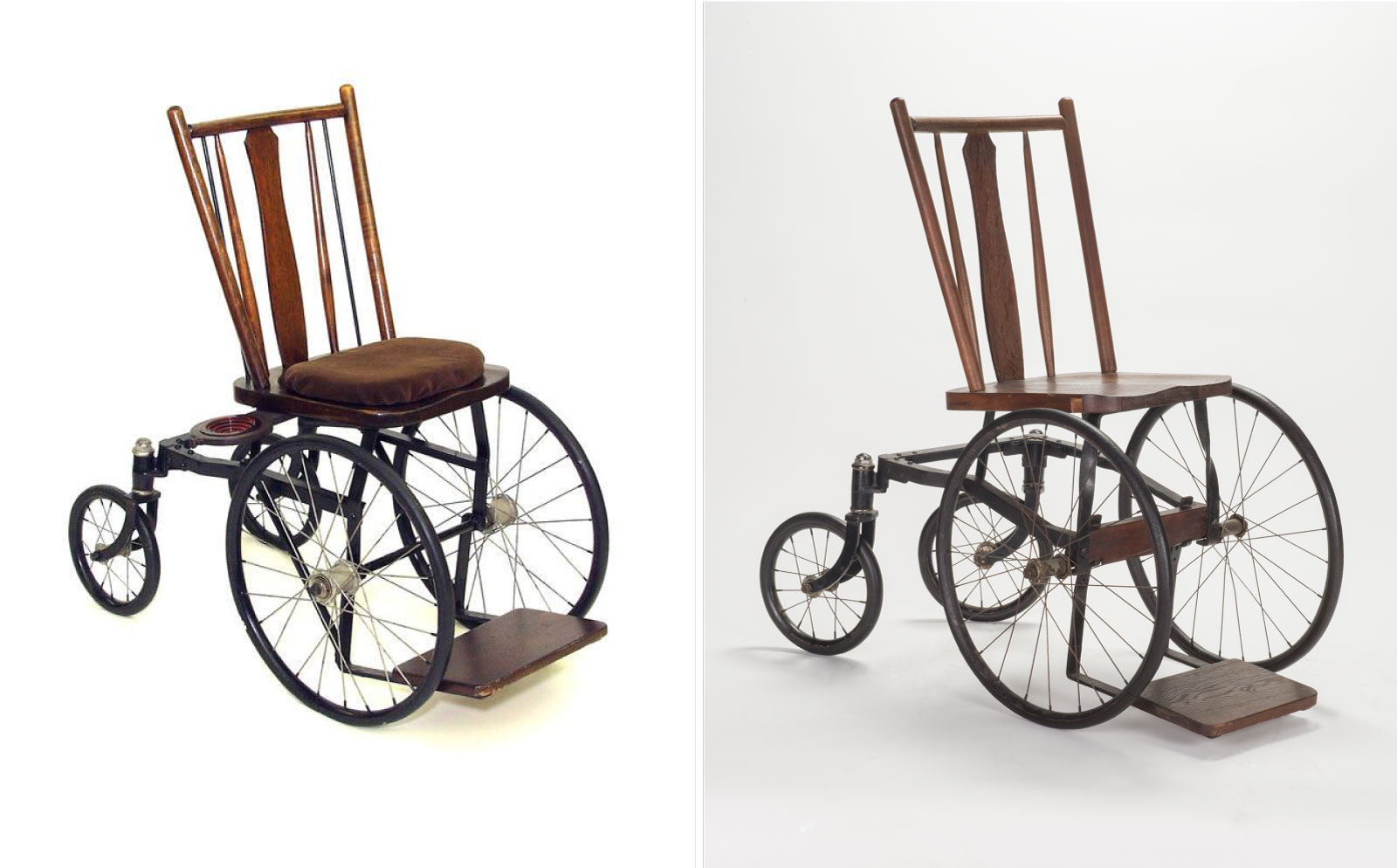
Left: Wheelchair in the collection of the Home of Franklin D. Roosevelt National Historic Site (HOFR 3042). NPS image. Right: Wheelchair in the collection of the Franklin D. Roosevelt Presidential Library. Courtesy of the Franklin D. Roosevelt Presidential Library and Museum, Hyde Park, New York.
The design of another wheelchair at Springwood (HOFR 3042) and a nearly identical wheelchair at the Franklin D. Roosevelt Presidential Library is also attributed to FDR. The wood seats of both chairs appear to be “little kitchen chairs” as described by Roosevelt. The FDR Library wheelchair retains the original loose seat cushion and includes the addition of an ashtray attached to the underside of the seat. Minor variations between the wheelbases of these two chairs suggest that one might be the prototype for a commercially produced wheelchair sold by the Georgia Warm Springs Foundation. An advertisement appearing in the Polio Chronicle provides the brief history:
The chair pictured above is in general use at Warm Springs, having been introduced here by a patient. It is especially useful as a house chair and will go through even narrow doors. Previously, these chairs have been made for us only by special order and were not offered for sale. A surgical supply house is now building these for us and we are able to offer them for sale at $35.00 each.8

Left: Profile of wheelchair in the collection of the Home of Franklin D. Roosevelt National Historic Site. NPS image. Right: Advertisement published in the Polio Chronicle, August 1931, depicting the armless wheelchair designed by a patient at Warm Springs. Photo courtesy of Roosevelt Warm Springs Vocational Rehabilitation Campus, Digital Library of Georgia.
We may speculate that FDR is the “patient” credited with the design, but nothing beyond circumstantial evidence has surfaced to prove the attribution. The history of FDR’s wheelchairs remains elusive. Currently, there are no known records indicating when FDR first ordered the construction of his own custom wheelchairs, how many of these wheelchairs were made, or who made them. Yet despite these unanswered questions, we hope that this closer look at FDR’s wheelchairs, the details of their designs and distinctions, and the circumstances of their existence, will demonstrate that objects can convey meaningful stories. Even though they may have become a prototype for broader use, FDR’s wheelchairs were thoughtful adaptations to meet the needs and requirements of his individual experience. The suggestion of independence subscribed to FDR’s wheelchairs raises an interesting contradiction within their attributes for more independence and access. Omission of the hand rims on most of these chairs indicate the unlikeliness that FDR moved without assistance. FDR’s social status, wealth, and privilege provided him a level of assistance not available to most wheelchair users. Family, friends, secret service agents, personal valets, and bodyguards were always available to lend a hand wheeling the president. And it was not necessarily a secret. Many published accounts revealed the truth, as in a 1934 article in the New Yorker stating that “he is almost always pushed to the west end of the White House in a small wheelchair.”9
Leg braces, splints, crutches, canes, and wheelchairs have tremendous potential to mark their users almost exclusively as disabled individuals. There are many ways we can see the meaning of a wheelchair. Those meanings have changed over time and are still changing. While we once saw FDR’s wheelchairs only as a symbol of overcoming dependency, deficiency and loss, we might now explore them as symbols of creativity and empowerment for an individual who wished to be the architect of his own identity.
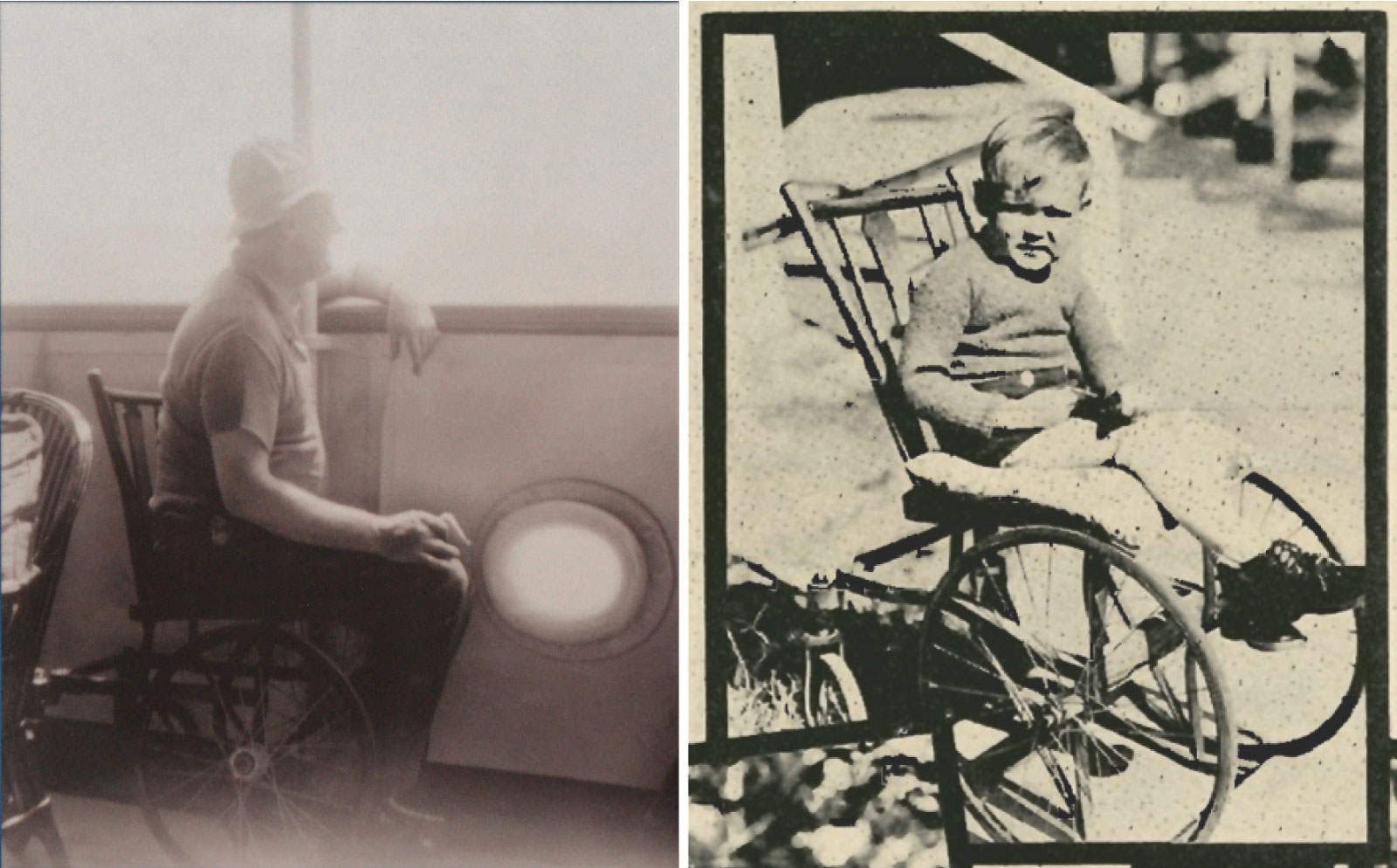
Left: Franklin D. Roosevelt in his wheelchair (HOFR 3042) aboard Vincent Astor’s Yacht ‘Nourmahal’ in April 1935. Courtesy of the Franklin D. Roosevelt Presidential Library and Museum. Right: Photograph of a young patient at Warm Springs, Georgia in a wheelchair that resembles FDR’s custom chair, published in the June, 1932 issue of the 'Polio Chronicle.' Photo courtesy of Roosevelt Warm Springs Vocational Rehabilitation Campus, Digital Library of Georgia.

Franklin D. Roosevelt in his wheelchair (HOFR 1554) with a group assembling on the terrace of Springwood in Hyde Park, September 12, 1937. Courtesy of the Franklin D. Roosevelt Presidential Library and Museum, Hyde Park, New York.
NOTES
1 “I Remember Hyde Park,” February 1963 issue of McCall’s, 73.
2 According to one published source, “Roosevelt’s wheelchair was an old-fashioned, armless kitchen chair with a platform for his feet to rest on and four six-inch wheels that had been attached to the bottom of the chair by the village blacksmith at Hyde Park.” See Richard Thayer Goldberg, The Making of Franklin D. Roosevelt: Triumph Over Disability, (Cambridge, MA: Abt Books, 1981), 171. The 1930 US Census for Hyde Park, NY identifies James Albert Wigg (1876-1940) as a local blacksmith. According to Wigg’s obituary, he was the third generation of the Wigg family to conduct the black-smith shop at Hyde Park and claimed the distinction of shoeing horses for the Roosevelt family. See Wigg’s obituary from The Poughkeepsie Star and Enterprise, cited in Find a Grave, database and images (accessed 26 February 2023), memorial page for James Albert “Bert” Wigg (9 Feb 1876–7 Aug 1940), Find a Grave Memorial ID 166317463.
3 See itemized account statement from Arthur Carpenter, Resident Trustee, Georgia Warm Springs Foundation to Marguerite LeHand, dated 21 March 1934 in Franklin D. Roosevelt, Papers as President: The President's Secretary's File (PSF), 1933-1945, Series 5, Box 170 “Warm Springs, 1933 - June 1934,” Franklin D. Roosevelt Presidential Library.
4 “FDR and His Automobiles.” The Little White House Newsletter. Autumn 2016: 1.
5 Arthur Schlesinger, Curtis Roosevelt, Michael R. Deland, Fulton Wilcox, and Dick Kaufman. "FDR's Wheelchair." The Wilson Quarterly (1976-) 29, no. 4 (2005), 9.
6 Quoted in Hugh Gregory Gallagher, FDR’s Splendid Deception (Arlington, VA: Vandamere Press, 1994): 93-94.
7 Elliott Roosevelt and James Brough, The Roosevelts of Hyde Park: An Untold Story (G.P. Putnam’s Sons, 1973), 174.
8 “Mechanical Hints.” Polio Chronicle. August 1931.
9 Quoted in Matthew Pressman, “The Myth of FDR’s Secret Disabiity,” Time Magazine, 12 July 2013.

